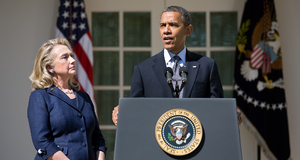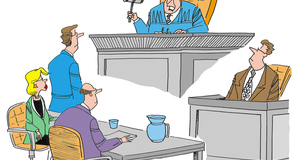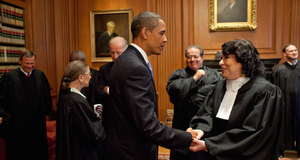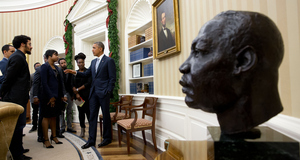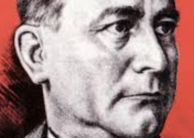The Obama PresidencyHow Eric Holder's Role as Attorney General Impacted the Obama PresidencyAnalyzing Holder Through the “McGinnis” FrameworkPublished in the Cardoza Law Review, the article “Models of the Opinion Function of the Attorney General: A Normative, Descriptive and Historical Prolegomenon,” by John O. McGinnis provides a sufficient framework through which Eric Holder’s work as attorney general can be analyzed qualitatively. McGinnis argues that up until that time, an AG’s opinions (primarily in the form of published opinions through the Office of Legal Council) had been mentioned in other written works but had never been analyzed as a whole body of work that could be used to determine the impact of the executive branch and AG’s influence on constitutional theory. McGinnis’ endeavor in the form of the creation of this model will assist my analysis of Eric Holder because this article’s end goal is to be able to understand the impact Holder’s work has had on the Obama Presidency and, to a greater degree, what mark that presidency may have on American history. The models McGinnis employs include the “independent authority” model, “court centered” model, and the “situational model.” McGinnis briefly explains: “The first model I have labeled the court-centered model because it is premised on the contention that the Attorney General is obliged in his legal opinions to follow the precedents laid down by the Supreme Court. The second model is labeled the independent authority model because it is premised on the contention that the President has the authority to interpret the law as he believes it should be interpreted independent of Court precedent. The final model is the situational model in which the President simply interprets the law to advance his political objectives…”21 Each model will be expanded upon below in order to provide an understanding of how Eric Holder’s published opinions will be reviewed.Just as the quote above implies, the court centric model of the AG relies on an observation that the AG is heavily reliant on precedence set by the court as the best way to interpret and apply the law. The most stringent understanding of this model holds true to the constitutional belief that the holdings of the Supreme Court are considered to hold the same supreme authority as that of the constitution. However, McGinnis points out, there are two different applications of this model. The court system is bound by its institutional interpretations of the constitution (which has its limitations) as well as analytical interpretations. A strict adherent to the court centric model would only interpret law independently from the judicial court when the court itself acknowledged an institutional limitation to its interpretation. A more loose employment of the court centric model results in greater executive autonomy and increased room for interpretation. Another way of interpreting this model in the way the AG acts as the enforcer of past rulings. In other words: In what ways has the AG made sure that the holdings of the Supreme Court and constitutional law are enforced and upheld throughout the United States? The independent authority model holds strongly to the notion that even the rulings of the Supreme Court should not be exempt from challenge. The Founders aimed to create a balance of power between the branches of government. Why then should not the judicial branch be subject to challenge from the executive? The Supreme Court has held erroneous decisions in the past and it is through the use of an independent authority model that those errors can be reversed. Another way to look at the independent authority model is to consider that because the AG and executive branch are bound by the constitution, they are obliged to determine if they should in fact execute the Court’s precedence. There are limitations on the independence of the executive branch to act in this way. The judgments of the Court and precedence of the Court are two different things. Executive independent legal interpretation does not permit the challenge of Court judgments, only of Court precedence. According to McGinnis, “ It is thus not surprising that even adherents of the autonomy of executive branch legal interpretation among the founding generation conceded that court judgments must be obeyed even though these judgments did not create binding precedent.”22 Without this constraint, the independent authority model would become the situational model. The situational model would imply that the AG acts on his own prerogative when interpreting the law. He acts as an attorney who must do what is right for his client, the President of the United States. The logic behind this approach is that as long as the laws in the constitution are not being directly broken, then the executive branch has the authority to write opinions as he see it fit. The oath that the President (and consequently the AG) make to “take care that the Laws be faithfully executed,” according to McGinnis, “is simply a requirement not to suspend or ignore laws that Congress has passed.”23 Under this model the AG would consider Court precedent but only when not following precedent may result in politically unfavorable outcomes. In defense of this approach, protecting the President by seeing to it that legal interpretation supports his actions can mean advancing the will of the people. Since the President theoretically represents the popular will, the executive interpretation is one that represents that will. The Founders of the constitution considered the will of the people to be of utmost importance, providing further defense for this model. Before examining Holder’s role in each respective model, it is important to make a few important notes. First, McGinnis acknowledges the importance of using evidence for analyzing the AG’s position from institutions that fall under him. Although the documents do not come from the AG directly, they come from the institutions he is responsible for, deeming them a reliable source for determining the AG position legal stance. For the purposes of this analysis, documents from a variety of subcabinets under the direction of the AG providing legal interpretation will be utilized as well as publically published statements by Holder and individuals under him. Additionally, it should be noted that McGinnis insists that all of these models can be applied to one AG and that rarely an AG will only satisfy one model. With these items in mind, an analysis of Eric Holder as Attorney General with the use of this model follows. Examples of Holder in a Court-Centered ModelIt has been over a century since Theodor Roosevelt first proposed health care reform. President Bill Clinton made a valiant effort to get a bill passed that would finally address the growing health care crisis in American society. Although the failure was an embarrassment to the Clinton administration, President Obama signed the Patient Protection and Affordable Care Act (ACA) in March 2010, considered to be his landmark achievement in office and Presidential legacy. The way in which the AG Court-Centered Model can be applied is the defense of the ACA during the State of Florida v. United States Department of Health and Human Services. In a Memorandum written by Assistant Attorney General Tony West, which was filed in response to the Plaintiffs’ motion for Summary Judgment, the memo essentially outlines the ways in which the government planed to defend the ACA in front of the Supreme Court and uses legal precedence and references the constitution to build its foundation. In responding to an allegation asserted by the plaintiff that the minimum coverage provision is not a valid exercise of congress’s power under the commerce and necessary and proper clauses, the government cites precedence.24 But before doing so, the defense underlines the courts institutional limitations that they are obliged to follow, which is perhaps a way in which the AG was looking to expand its autonomy in interpreting the legality of the ACA. In defending the ACA the government asserts that the economic, societal and legal issues surrounding healthcare were resolved through the cooperation and execution of powers by the executive and legislative branches of government. The government heeds as a warning from DaimlerChrysler Corp. v. Cuno, “ Determining that a matter before the federal courts is a proper case or controversy under Article III therefore assumes particular importance in ensuring that the Federal Judiciary respects ‘the proper – and properly limited- role of the courts in a democratic society.25 Interestingly, in McGinnis’ explanation of an exception in which the AG can gain significant autonomy within the Court Centered model, he discusses the cases in which there may be justifiability barriers posed by the “cases and controversies” requirement of Article III. McGinnis states that under these rare circumstances, the AG still has an obligation to follow precedence as but: “Given that constraints of a multi-member decision-making body make it difficult, if not impossible, for a court to apply a consistent interpretative methodology across substantive areas, the Attorney General will nevertheless have, as a practical matter, enormous autonomy in these areas of a kind not enjoyed by inferior courts.” 26 With McGinnis’ perspective in mind, it is possible that the President’s lawyers were using Article III judiciary limitations as a way to increase their own autonomy in interpreting the legality of the ACA. Although this action may sound like the independent authority model or the situational lawyer model, Tony West aligns with the requirement within the court centric model that even when there may be institutional limitations on the judiciary, the AG must still look for precedent that best fits the case. West provides a wide variety of available precedent to defend the constitutionality of the ACA. In a previous case, Anthony Shreeve et al., v. Obama, district court judge Curtis L. Collier explained that due to the economic nature of gaining health insurance including the rationale that human beings cannot opt out of the healthcare market and how individuals choose to pay for their insurance has a “documented impact on interstate commerce.” According to Judge Curtis, these factors about the health care market makes a rationale basis for Congressional action to be taken to address the issues in this market.27 The Government’s use of precedence, even though it has come from a lower court, provides evidence that Attorney General Eric Holder and his offices are using a court-centered approach in their defense of the ACA. Additionally, and also in line with the court centered model, the government cites various other horizontal precedence including United States v. Salerno, 481 U.S. 739, 745 (1987), New York v. United States, 505 U.S. 144 (1999) and Printz v. United States, 521 U.S. 898 (1997). All in all, the defense of the ACA in this memo provides an example of the AG and his offices employing a stronger version of the executive branch authority. However, even if the government’s actions in this case does not qualify it as a strict adherent to the court centered model, the use of precedence both from the lower courts and supreme court rulings imply that the court centered model still applies here. Another interpretation of the application of the court-centered model is an assessment of the Attorney General as the enforcer of past Federal Court rulings and provisions made to the constitution. In order to determine Eric Holder’s fulfillment of his role as the “chief enforcer” of Federal Law, an analysis of how the Department of Justice has aimed to enforce the SaVe Provision to the Violence Against Women’s Act (VAWA) of 1994 across the United States will provide a better understanding of this. Since the Violence Against Women Reauthorization was signed by President Obama in March 2013, the DOJ, primarily through the Office of Violence Against Women, have made various statements and donated millions of dollars toward grants programs meant to create incentives for schools around the US to enforce the new provision. The new provision makes changes and additions to the VAWA including new requirements for universities and colleges: increased reporting measures of cases involving domestic violence, dating violence and stalking; enforce student discipline procedures; adopt institutional policies that aim to educate men and women about sexual assault particularly in respects to institutional personnel as a way to prevent campus sexual violence. 28Additionally, the provision closed a loop through which many Native American women were not protected under the Federal Government. On February 28, 2013, AG Eric Holder made a public statement supporting the passage of the Act in the House. “ I applaud Congress for passing a bipartisan reauthorization that protects everyone – women and men, gay and straight, children and adults of all races, ethnicities, countries of origin and tribal affiliations. The DOJ looks forward to implementing this historic legislation after it is signed in law.” 29The DOJ aimed to “implement this historic legislation,” in a variety of ways. In April of this year, the DOJ announced a University Tour to Raise Awareness of Sexual Assault. DOJ administration officials would travel to various college campuses around the US and sharing best practices and procedures in areas of awareness, prevention and peer support. Principal Director of the Office on Violence Against Women (VAW) Bea Hanson said, “The federal government is proud to partner with hundreds of campuses across our country to improve safety for students with comprehensive solutions to both prevent acts of violence and to support victim services.” 30 In addition, the Office of VAW created two new grants worth approximately $3 million for its Bakken region initiative targeted to helping rural and tribal communities located in western North Dakota and eastern Montana.31 In September 2014, Eric Holder announced that four sites around the country would receive a total of $2.6 million to create and implement models to prevent domestic violence homicide. Holder said, “Under the Violence Against Women Act, which was reauthorized last year, the Department of Justice is taking vital action to protect and empower women and partners who are being exploited and abused.” 32Each example supports Eric Holder executing the court centric model specifically as an enforcer of the VAWA in the ways that himself and his office have worked to ensure its implementation across the US. Examples of Holder in the Situational Lawyer ModelIn the situational lawyer model, the AG acts as the President’s lawyer. The two engage in a lawyer-client type relationship in which the AG is pressured to interpret law that best satisfies the interests of the executive branch. In 2011drone strike in Yemen, American citizen and alleged al Queda operative, Anwar al-Awlaki was killed. Since then, the legal justifications behind drone strikes have come under speculation. The justification for Anwar al-Awlaki came from the Office of Legal Counsel (OLC) and was written by Acting Assistant Attorney General David Barron. In the memo, Barron opens with discussing 18 US Code Sec 1119. The section states that murder of an American citizen overseas is considered murder at home, and the murderer should be tried just the same as a murder within US borders. Barron argues that the “public authority” justification applies in this circumstance. Essentially, the Public Authority justification is the same justification used for public officials: “ …for example, the application of a speed law to a policeman pursuing a criminal or the driver of a fire engine responding to an alarm.”33 Barron is trying to make the case that the executive branch’s decision to use a drone strikes abroad on an American citizen without due process is the same as a police officer speeding through traffic with their siren on. It is clear that the application of the “public authority” justification is a stretch. Additionally, Barron uses the Authorization for the Use of Millitary Force (AUMF), the law that Congress passed in 2001 permitting the use of force against al Qaeda. The AUMF according to Barron’s interpretation: “By authorizing the use of force against ‘organizations’ that planned, authorized, and committed the September 11 attacks, Congress clearly authorized the President’s use of “necessary and appropriate” force against al Qaeda forces, because al Qaeda carried out the September 11 attacks.” 34 However, the bill does not explicitly say that the necessary and appropriate clause applies to killing Americans abroad. It should also be noted that according to the National Security Network, the 2001 AUMF lacks limitations on characteristics for the employment of the “necessary and appropriate force” authorization.35 Barron, then, has utilized the loopholes present in the 2001 AUMF to his advantage. McGinnis offers of the situational model that the only real constraints the AG faces under this model (including one of three): “ the more general need to cultivate the appearance of fidelity to the law that is probably expected by the public of the President and his subordinates.” 36 In this case, Barron cites laws in this memo not to enforce them, but instead to make justifications for the actions looking to be pursued by the executive branch. Therefore, Barron’s work under Holder’s direction is a reflection of Holder’s AG position within this model of the “president’s lawyer.” Another such example includes the way Holder’s office handled an investigation of the way some CIA operatives treated detainees. The investigation began in the end of Bush’s second term and Assistant US attorney John Durhman of District of Columbia was chosen to head the investigation into the destruction of CIA interrogation tapes. From early on in Obama’s presidency, his administration made it very clear that interrogation techniques that included torture were considered unconstitutional. The administration also promised to increase government transparency. In 2009, AG Eric Holder broadened Mr. Durhman’s investigation to include a preliminary review into whether interrogation techniques were used on detainees overseas. Holder made it clear that if the actions of the CIA were in line with the guidance provided by the Office of Legal Counsel on lawful interrogation techniques at the time those actions were committed, no legal action would be taken. As a result of Durhman’s investigation, it was determined that the death of two detainees held in American custody should be further investigated, but suggested that all other matters be closed. Holder followed Durhman’s advice and opened two criminal investigations but announced on August 30th 2012 that the cases would be closed.37 During the investigation, Holder said Durhman referred various sources, including the Office of Legal Counsel’s enhanced interrogation techniques memorandum. Although Holder and his offices didn’t follow through with prosecuting the alleged individuals for possibly employing “enhanced interrogation techniques,” the OLC under the direction of President Obama removed several memorandums published during the Bush administration. On April 15, 2009 in a Memorandum from the OLC, David Barron quoted from the President’s executive order 13491 in which he directs, “ Unless the Attorney General with appropriate consultation provides further guidance, officers, employees and other agents of the United States Government may not, in conducting interrogations, rely upon any interpretation of the law governing interrogation… issued by the Department of Justice between September 11, 2001 and January 20, 2009.”38 Barron listed a number of past memos that had been published under the OLC that no longer reflected the legal interpretations of that office. By reversing a past administrations opinions and instead enforcing the President’s executive order suggests and Attorney General role of the situational model. Instead of citing legal precedence, Holder and his office chose to enforce the executive branch’s interpretation of the use of enhanced interrogation techniques. In this context, the interest of President Obama to end all possible use of enhanced interrogation, no matter how ideal or admirable the effort, was supported by Barron’s memo written to satisfy the interests of his client. McGinnis writes that the use this particular model aims to preserve the “pursuit of the President’s particular political interest on a case-by-case basis. ”39 Both examples then, aim to do just that. Examples of Holder in the Independent Authority ModelThe Defense of Marriage Act (DOMA), enacted in September 1996, came in front of the Supreme Court in 2013. The decision made by Eric Holder and President Barack Obama to challenge the case rather than defend it defies the traditional procedural processes. Typically, the DOJ defends statutes against constitutional challenge. However, in this case, both the President and his AG felt that the current statute fails to uphold the Fifth Amendment’s guarantee of equal protection. As a result, Holder had no moral choice but to follow through with a letter written to John Boehner, speaker of the house, announcing that Congress would have to take on the role of defending DOMA. In the letter, Holder writes, “ …the President and I have concluded that classifications based on sexual orientation warrant heightened scrutiny and that, as applied to same-sex couples legally married under state law, Section 3 of DOMA is unconstitutional.”40 As scholars analyze this decision, it is unclear if the President and AG Holder’s decision fall in line with past practice or theory, making it seem as though Holder is employing the Independent Authority model through his choice. The independent authority model provides some leniency in how the AG interprets law within the scope of precedence and constitutionality. According to McGinnis, the AG’s ability to challenge the Courts and the Constitution brings better balance of power between the branches of government. In a theory studied by academics in the field of constitutional law, the notion of departmentalism requires that the President decline to uphold laws believed to be unconstitutional.41 One flaw with this theory is that there is no limitation on which the President and his lawyer can challenge the authority of Congress or the Supreme Court, creating a fear that instead of balance power between branches, it instead increases power in the executive branch. However, the ideas expressed in the theory of departmentalism are supported in McGinnis’ model of the Attorney General as an independent authority. McGinnis argues, “If the President and his subordinates within the executive branch have the authority to interpret the Constitution independent of the Court, they may insure that the debate about first constitutional principles is ever renewed and no usurpation is entrenched beyond challenge.42 In regards to a civic liberties case of a different kind, AG Eric Holder acted accordingly. In June 2013, after the Supreme Court had decided to strike down an essential part of the voting rights act in Shelby County v. Holder, Eric Holder made a public statement in which he clearly disagreed with the Court’s decision. Holder stated, “ This decision represents a serious set back for voting rights – and has the potential to negatively affect millions of Americans across the country.”43 Holder goes on to describe that if any jurisdiction sought to use the decision of the Court to hinder eligible voters from executing that right, that the Department of Justice will “use every legal tool that remains available,” to ensure that it does not occur.44 Holder’s strong wording and clear stance against the Courts decision provides as further evidence in his role as an AG in the independent authority model.Continued on Next Page » Suggested Reading from Inquiries Journal
Inquiries Journal provides undergraduate and graduate students around the world a platform for the wide dissemination of academic work over a range of core disciplines. Representing the work of students from hundreds of institutions around the globe, Inquiries Journal's large database of academic articles is completely free. Learn more | Blog | Submit Latest in Law & Justice |








